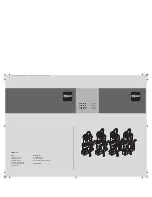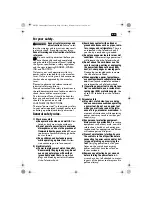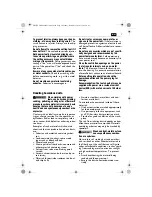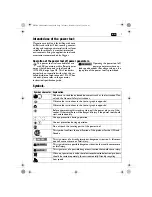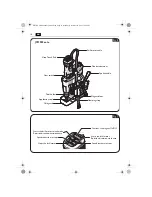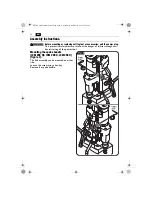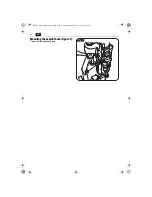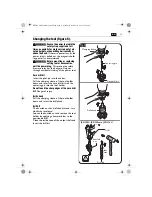
5
en
To prevent injuries, always keep your hands,
clothing, etc. away from rotating swarf.
The
swarf can cause injuries. Always use the chip-
ping protector.
Do not attempt to remove the cutting tool if it
does not turn.
This can lead to serious injuries.
Hold power tool by insulated gripping sur-
faces when performing an operation where
the cutting accessory may contact hidden
wiring or its own cord.
Cutting accessory con-
tacting a “live” wire will make exposed metal
parts of the power tool “live” and shock the
operator.
Beware of any concealed electric cables, gas
or water conduits.
Check the working area
before commencing work, e. g. with a metal
detector.
Do not machine any material containing
asbestos.
Asbestos is cancerogenic.
Do not rivet or screw any name-plates or
signs onto the power tool.
If the insulation is
damaged, protection against an electric shock
will be ineffective. Adhesive labels are recom-
mended.
Do not use accessories which are not specifi-
cally designed and recommended by the
power tool manufacturer.
Safe operation is
not ensured merely because an accessory fits
your power tool.
Clean the ventilation openings on the power
tool at regular intervals using non-metal
tools.
The blower of the motor draws dust
into the housing. An excessive accumulation
of metallic dust can cause an electrical hazard.
Before putting into operation, check the
power connection and the power plug for
damage.
Recommendation: The tool should always be
supplied with power via a residual current
device (RCD) with a rated current of 30 mA or
less.
Handling hazardous dusts.
When working with power
tools, such as when grinding,
sanding, polishing, sawing or for other work
procedures where material is removed, dusts
develop that are both hazardous to one’s
health and can spontaneously combust or be
explosive.
Contact with or inhaling some dust types can
trigger allergic reactions to the operator or
bystanders and/or lead to respiratory infec-
tions, cancer, birth defects or other reproduc-
tive harm.
Examples of such materials which contain
chemicals that can produce hazardous dusts,
are:
–
Asbestos and materials containing asbes-
tos;
–
Lead-containing coatings, some wood
types such as beech and oak;
–
Minerals and metal;
–
Silicate particles from bricks, concrete and
other materials containing stone;
–
Solvent from solvent-containing paint/
varnish;
–
Arsenic, chromium and other wood pre-
servatives;
–
Materials for pesticide treatment on boat
and ship hulls;
–
Stainless steel dust, metal dust and non-
ferrous metal dust;
To minimize the unwanted intake of these
materials:
–
Use dust extraction matched appropriately
for the developing dust.
–
Use personal protective equipment, such
as a P2 filter-class dust protection mask.
–
Provide for good ventilation of the work-
place.
The risk from inhaling dusts depends on how
often these materials are worked. Materials
containing asbestos may only be worked by
specialists.
Wood and light-metal dust can
cause spontaneous combus-
tion or explosions.
Hot mixtures of sanding dust and paint/var-
nish residuals or other chemical materials in
the filter bag or the vac filter can self-ignite
under unfavourable conditions, such as spark-
ing from sanding metal, continuous sunlight
or high ambient temperatures. To prevent
this:
–
Avoid overheating the material being
sanded and the power tool.
–
Empty the dust collector/container rou-
tinely.
WARNING
CAUTION
OBJ_BUCH-0000000130-002.book Page 5 Monday, November 18, 2013 10:38 AM

